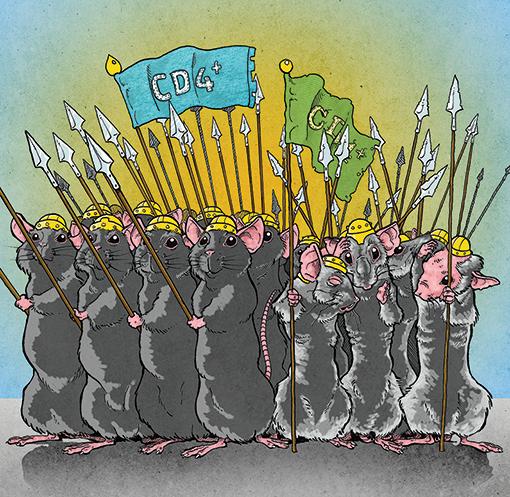![Single-cell RNA sequencing of T cells in young and old mice reveals that aging causes cell coordination breakdown. As T cells lose transcriptional uniformity, they show weaker upregulation of a core activation program and fight infection less effectively. [Spencer Phillips, The European Bioinformatics Institute]](https://genengnews.com/wp-content/uploads/2018/08/Mar31_2017_SpencerPhillips_TCell_MiceCartoon1382230153-1.jpg)
Single-cell RNA sequencing of T cells in young and old mice reveals that aging causes cell coordination breakdown. As T cells lose transcriptional uniformity, they show weaker upregulation of a core activation program and fight infection less effectively. [Spencer Phillips, The European Bioinformatics Institute]
Immune cells in older tissues lack coordination and exhibit much more variability in gene expression compared with their younger counterparts. This finding, which was derived from single-cell sequencing results, may help resolve a longstanding question: Why is aging accompanied by functional decline?
Answers to this question are being sought at the cellular and molecular levels. One possibility is that functional degradation is caused by a loss of cellular performance. Another possibility is that there is a loss of cell-to-cell coordination. These alternative mechanisms may be more or less important from tissue to tissue.
Immune tissue, specifically CD4+ T cells, attracted the interest of researchers from the European Bioinformatics Institute (EMBL-EBI), University of Cambridge, the Wellcome Trust Sanger Institute, and the Cancer Research UK–Cambridge Institute (CRUK–CI). These researchers sequenced the RNA of naïve and memory CD4+ T cells in young and old mice, in both stimulated and unstimulated states. Doing so allowed the scientists to resolve gene-expression patterns in individual cells, rather than settle for analyzing “average” gene expression profiles.
“You could think of DNA sequencing as a fruit smoothie,” explained John Marioni, group leader at EMBL-EBI and at CRUK–CI. “Traditional sequencing technology is a bit like taking a sip of the smoothie, then trying to guess what the ingredients are. Single-cell genomics now lets us study the ingredients individually, so we get direct insight into the constituent parts. Extrapolating, this means that single-cell sequencing allows researchers to individually look at thousands of genes at any given time.”
Details of the new research appeared March 31 in Science, in an article entitled, “Aging increases cell-to-cell transcriptional variability upon immune stimulation.” According to this article, loss of coordination is a key component of the impaired immune performance caused by T cell aging.
“In young animals, immunological activation drives a conserved transcriptomic switch, resulting in tightly controlled gene expression characterized by a strong up-regulation of a core activation program, coupled with a decrease in cell-to-cell variability,” the article’s authors wrote. “Aging perturbed the activation of this core program and increased expression heterogeneity across populations of cells in both species.”
Essentially, aging T cells falter transcriptionally, falling out of step with each other. As their ranks grow more ragged, they become increasingly less effective as an infection-fighting force.
Duncan Odom, Ph.D., group leader at the University of Cambridge's CRUK–CI and associate faculty at the Wellcome Trust Sanger Institute, elaborated on the military analogy: “Imagine the immune system as a ‘cell army,’ ready to protect the body from infection. Our research revealed that this army is well coordinated in young animals, with all the cells working together and operating like a Greek phalanx to block the infection.”
Dr. Odom went on to explain that this tight coordination makes the immune system stronger, and allows it to fight infection more effectively. The team's study shows that as the animal gets older, cell coordination breaks down.
“Although individual cells might still be strong, the lack of coordination between them makes their collective effectiveness lower,” Dr. Odom concluded.
Previous studies have shown that in young animals, immunological activation results in tightly regulated gene expression. The current study further reveals that activation results in a decrease in cell-to-cell variability. Aging increased the heterogeneity of gene expression in populations of two mice species, as well as in different types of immune cells. This suggests that increased cell-to-cell transcriptional variability may be a hallmark of aging across most mammalian tissues.
“There is a great deal of interest in how biological aging happens, but not much is known about molecular ageing,” noted Celia Pilar Martinez-Jimenez, Ph.D., experimental lead and postdoctoral fellow at the Sanger Institute and CRUK–CI. “This research initiative explored a new facet of cell response to disease, while also tackling questions related to aging.”
Nils Eling, computational lead of the project and Ph.D. student at EMBL-EBI and CRUK–CI highlights that “the advantage of analyzing gene expression from single cells is to detect how cell populations synchronize their response. It is interesting to see that ageing strongly distorts this response—a phenomenon which could not be observed before.”
The interdisciplinary study paves the way for a more in-depth exploration of the mechanisms by which different types of cells age. It also illustrates the potential of single-cell sequencing to enable a richer understanding of cell development and activity.







